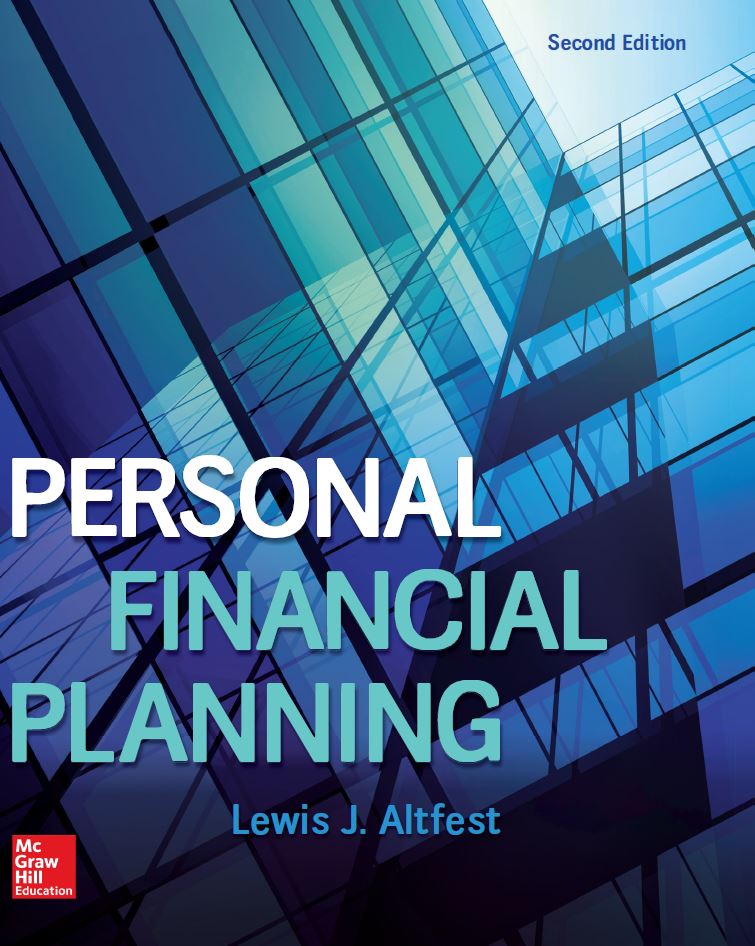Description
Test Bank For Personal Financial Planning 2nd Edition By Altfest
Test Bank Questions, Chapter 2
- The time value of money is best defined as:
-
- The compensation provided for investing money for a given period.
- The concept that investing is always superior to consumption.
- The concept that the value of the exchange rate varies over time.
- The compensation provided for carefully timing one’s investments.
- None of the above.
Answer: a
- You are given the choice between receiving $100,000 today or $100,000 in one year. Which of the following statements is accurate?
-
- You would prefer to receive $100,000 today, as you could invest the money and in one year have much more than the original $100,000.
- You would prefer to receive $100,000 today, as the present value of receiving $100,000 in one year is much less than $100,000.
- You would prefer to receive $100,000 today due to the time value of money.
- All of the above statements are accurate.
- None of the above statements are accurate.
Answer: d
- If the value of the principal today is $25,000 and the interest rate is 22.5%, what is the value of the principal at the end of one year?
-
- $5,625
- $30,250
- $5,825
- $30,625
- None of the above.
Answer: d
- If the value of the principal today is $10,250 and the interest rate is 1.5%, what is the value of the principal at the end of three years?
-
- $10,540.45
- $10,718.20
- $10,900.35
- $12,245.45
- $12,234.43
Answer: b
- If the value of the principal today is $12,000 and the interest rate is 10.5%, what is the total compounding contribution at the end of two years?
-
- $125.25
- $100.56
- $132.30
- $450.50
- None of the above.
Answer: c
- If the value of the principal today is $25,250 and the interest rate is 2.25%, what is the total compounding contribution at the end of one year?
-
- $225.25
- $120.56
- $2.13
- $43.54
- $0
Answer: e
- If the value of the principal today is $1,560,250 and the interest rate is 11.25%, what is the total compounding contribution at the end of ten years?
-
- $1,215,472.15
- $1,560,250
- $0
- $2,430,966.30
- None of the above.
Answer: a
- If the value of the principal today is $2000 and the interest rate is 12.33%, what is the total simple interest income at the end of three years?
-
- $2,739.80
- $739.80
- $2,657.30
- $787.21
- None of the above.
Answer: b
- If the value of the principal today is $17,567 and the interest rate is 0.93%, what is the total simple interest income at the end of fifteen years?
-
- $17,567
- $2,540.60
- $82,765.65
- $300.56
- None of the above.
Answer: b
- If the value of the principal today is $10,000 and the interest rate is 21.22%, what is the total compound interest income at the end of six years?
-
- $21,728.22
- $25,567.43
- $20,000.54
- $45,067.22
- None of the above.
Answer: a
- If the value of the principal today is $230 and the interest rate is 1.33%, what is the total compound interest income at the end of 2 years?
-
- $45.67
- $22.54
- $6.16
- $5.78
- None of the above.
Answer: c
- The present value of a sum is:
-
- The value of the sum at the end of a given period of time.
- The value of the sum at the beginning of a given period of time.
- The value of investing the sum at the beginning of the given period of time rather than at the end.
- The value of investing the sum at the end of the given period of time rather than at the beginning.
- None of the above.
Answer: b
- The formula for present value is:
-
- PV = FV(1+i)n
- PV = FV(1+n)i
- PV = FV / (1+n)i
- PV = FV / (1+i)n
- None of the above.
Answer: d
- What is the present value of $100,500 to be received 23 years from now if the interest rate is 7.5 percent?
-
- $19,044.58
- $163,565.44
- $16,447.34
- $26,200.30
- None of the above.
Answer: a
- What is the present value of $25,250,300 to be received 73 years from now if the interest rate is 22.5 percent?
-
- $10,454,550.25
- $9.30
- $12,566.60
- $8,987,000.45
- $8,500,000.25
Answer: b
- The future value of a sum is a function of:
-
- The amount invested at the beginning of the period.
- The interest rate.
- The number of compounding periods.
- All of the above.
- None of the above.
Answer: d
- The formula for future value is:
-
- FV = PV(1+ )n
- FV = PV / (1+ )n
- FV = PV(1 / (1+ )n)
- FV = (1 / PV)(1+ )n
- None of the above.
Answer: a
- What is the future value of $25,000 invested today for the next 22 years if the interest rate is 17.5 percent?
-
- $200,200.87
- $868,506.50
- $1,200,000.45
- $1,250,000.54
- None of the above.
Answer: b





Be the first to review “Test Bank For Personal Financial Planning 2nd Edition By Altfest”